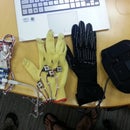Introduction: Control an Arduino With PHP
Here's how to make your Arduino do things from over the internet without an ethernet or wifi shield. This is a simple way to make your project controllable from anywhere in the world!
Step 1: Platform Compatability
This method WILL NOT work under Windows. I can't tell you how long it took me to figure that out. The command we're using, fopen() is not implemented the same way under Windows and Linux, so you have to use Linux. Never used it before? Don't panic, it's not that bad.
Step 2: Setting Up Your Server
You'll need to get a server running PHP for this to work. I'm going to assume you have a fresh copy of Ubuntu. There are literally thousands of tutorials on how to install Ubuntu, so I'll refer you to those if you don't.
Open a terminal and type:
sudo apt-get install php5 mysql-server apache2
It will prompt you for a root MySQL password, so give it one.
Open a browser and go to http://localhost. You should see a page that says "It works!". Next run this in a terminal:
sudo gedit /var/www/info.php
And paste in this code:
<?php
phpinfo();
?>
Save and close the file, then run
sudo service apache2 restart
Go to http://localhost/info.php
and you should see a purple table with a bunch of PHP stuff. If you do, congrats! You are now running a PHP server. Next, let's set up a page to control the Arduino.
Step 3: Touching the Serial Port in PHP
The core of this technique is the fopen() command. This is normally used for opening a document to edit within the code (like if you wrote a script to make a text file with some information in it and save it). Instead, we're going to exploit how linux views files and use it on a port. Install Arduino from the Ubuntu Software Manager. Plug in your Arduino and open the arduino window. You should see the device name under the ports menu. It will probably be /dev/ttyUSB0 or something similar. Here's some example code that will open that port as a file and write the numbers 1 to 6 based on what button is pressed:
<?php
$verz="1.0";
$comPort = "/dev/ttyUSB0"; /*change to correct com port */
if (isset($_POST["rcmd"])) {
$rcmd = $_POST["rcmd"];
switch ($rcmd) {
case Stop:
$fp =fopen($comPort, "w");
fwrite($fp, 1); /* this is the number that it will write */
fclose($fp);
break;
case Slow:
$fp =fopen($comPort, "w");
fwrite($fp, 2); /* this is the number that it will write */
fclose($fp);
break;
case Medium:
$fp =fopen($comPort, "w");
fwrite($fp, 3); /* this is the number that it will write */
fclose($fp);
break;
case Fast:
$fp =fopen($comPort, "w");
fwrite($fp, 4); /* this is the number that it will write */
fclose($fp);
break;
case Right:
$fp =fopen($comPort, "w");
fwrite($fp, 5); /* this is the number that it will write */
fclose($fp);
break;
case Left:
$fp =fopen($comPort, "w");
fwrite($fp, 6); /* this is the number that it will write */
fclose($fp);
break;
default:
die('Crap, something went wrong. The page just puked.');
}
}
?>
<html>
<body>
<center><h1>Arduino from PHP Example</h1><b>Version <?php echo $verz; ?></b></center>
<form method="post" action="<?php echo $PHP_SELF;?>">
    
<input type="submit" value="Left" name="rcmd">
          
<input type="submit" value="Right" name="rcmd"><br/>
<br />
               
<input type="submit" value="Stop" name="rcmd"><br/>
<br />
   
<input type="submit" value="Slow" name="rcmd">
<input type="submit" value="Medium" name="rcmd">
<input type="submit" value="Fast" name="rcmd">
<br />
<br />
<br />
<br />
<br />
<br />
</form>
</body>
</html>
Step 4: How It Works & the Arduino Side
Each time a button on the page is pressed, the case statement happens and the "file" (really the port) is opened, put into write mode, a single ASCII number is written, and then it's closed. You have to close it each time or else it won't work. On the Arduino side, simply read in from the serial port using Serial.read() in the loop(). I used a big if statement to check for each ASCII number, so if 1 is sent, then do one thing, if 2 is sent, do another thing, etc. Since you're running a PHP server, you can access the page on the server from anywhere in the world and it will control the Arduino. Here's some example arduino code I used to control some motors:
#include <Servo.h>
//First, set up the servos
Servo servo1;
Servo servo2;
int debugPin = 13; // used for an led to test stuff
int motor1Pin = 9; // the first motor's port number
int motor2Pin = 10; // the second motor's port number
int usbnumber = 0; //this variable holds what we are currently reading from serial
void setup() { //call this once at the beginning
pinMode(motor1Pin, OUTPUT);
pinMode(debugPin, OUTPUT);
pinMode(motor2Pin, OUTPUT);
servo1.attach(motor1Pin,1000,2000);
servo2.attach(motor2Pin,1000,2000);
Serial.begin(9600); //start up serial port
}
void loop() { //main loop
if (Serial.available() > 0) { //if there is anything on the serial port, read it
usbnumber = Serial.read(); //store it in the usbnumber variable
}
if (usbnumber > 0) { //if we read something
if (usbnumber == 49){
servo1.write(93);
servo2.write(93);//if we read a 1, stop
analogWrite(debugPin, 0);
}
if (usbnumber == 50){
servo1.write(120);
servo2.write(120); //if we read a 2, slow
analogWrite(debugPin, 85);
}
if (usbnumber == 51){
servo1.write(150);
servo2.write(150); //if we read a 3, medium
analogWrite(debugPin, 170);
}
if (usbnumber == 52){
servo1.write(179);
servo2.write(179); //if we read a 4, fast
analogWrite(debugPin, 255);
}
if (usbnumber == 53){
servo1.write(130);
servo2.write(50); //if we read a 5, right
analogWrite(debugPin, 255);
}
if (usbnumber == 54){
servo1.write(50);
servo2.write(130); //if we read a 6, left
analogWrite(debugPin, 255);
}
}
usbnumber = 0; //reset
}













